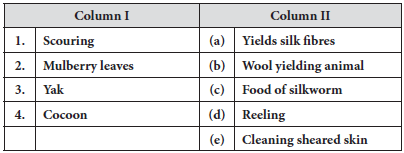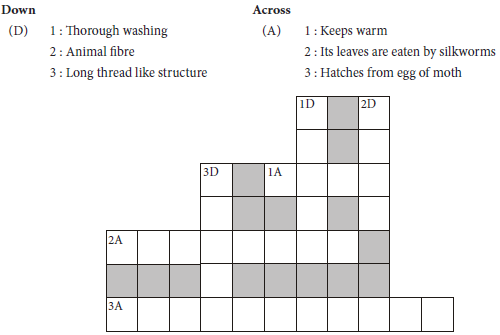Fibre and Fabric (Biology) Class 7 - NCERT Questions
You must be familiar with the following nursery rhymes:
(i) 'Baa baa black sheep, have you any wool.'
(ii) 'Mary had a little lamb, whose fleece was white as snow.'
Answer the following :
(A) Which parts of the black sheep have wool?
(B) What is meant by the white fleece of the lamb?
(A) The fine and soft under-hair that grow close to the skin of the sheep have wool.
(B) White fleece of lamb means the white hair (or fibres) present on the skin of lamb. The natural fleece of sheep and goats is black, brown or white.
The silkworm is (A) a caterpillar, (B) a larva. Choose the correct option.
(i) A (ii) B (iii) both A and B (iv) neither a nor b
Ans.: ✓ (iii) both a and b
Q 3.Which of the following does not yield wool? (i) Yak (ii) Camel (iii) Goat (iv) Woolly dog
SOLUTION:Ans.: ✓ (iv) Woolly dog
Q 4.What is meant by the following terms?
(i) Rearing (ii) Shearing (iii) Sericulture
(i) Rearing : It is raising and taking care of livestock (e.g. cows, buffaloes, goats etc.) for commercial purposes. These animals are fed, provided shelters and are bred for better yield of products like milk, meat, wool etc. For example, sheep are reared mainly for the wool. They are usually reared in areas with low rainfall. Reared sheep eat grass and leaves. They are also fed on a mixture of pulses, corn, jowar, oil cakes and minerals. In winters they are kept indoors and fed on dry fodder, leaves and grains.
(ii) Shearing : Once a sheep develops a thick coat of hair, it is shaved off to obtain wool. The process of removing the woolen fleece of sheep along with a thin layer of skin is called shearing. It is done by the shearing machine or by razor.
(iii) Sericulture : The breeding and management of silkworms for the production of silk is known as sericulture. Different types of silk (e.g. mulberry silk, tassar silk etc.) with different textures are obtained from different varieties of silk moths.
Given below is a sequence of steps in the processing of wool. Which are the missing steps? Add them.
Shearing, ................, sorting, ................, ...................., ..................... .
Shearing, Scouring, Sorting, Carding, Fibre dyeing, Spinning.
Q 6.Make sketches of the two stages in the life history of the silk moth which are directly related to the production of silk.
SOLUTION: 
Out of the following, which are the two terms related to silk production?
Sericulture, floriculture, moriculture, apiculture and silviculture.
Hints:
(i) Silk production involves cultivation of mulberry leaves and rearing silkworms.
(ii) Scientific name of mulberry is Morus alba.
Sericulture and moriculture are the two terms related to silk production.
Sericulture is the breeding and management of silkworms for the production of silk. Moriculture is the cultivation of mulberry plants for harvesting the leaves to be used for feeding the silkworms.
Match the words of Column I with those given in Column II :

1-(E), 2-(C), 3-(B), 4-(A)
Q 9.Given below is a crossword puzzle based on this lesson. Use hints to fill in the blank spaces with letters that complete the words.

